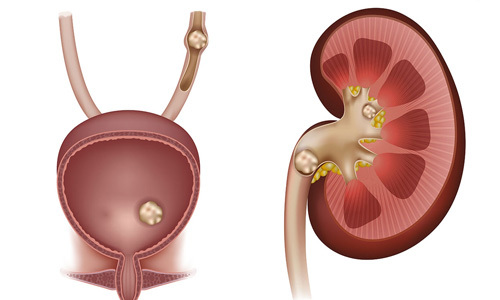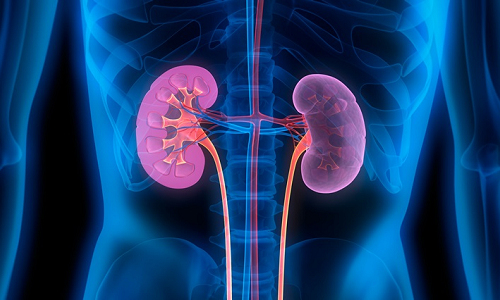The effectiveness of treatment of urolithiasis largely depends on their chemical composition. Usually, kidney stones are multilayered. In general, types of kidney stones are classified according to size, surface texture, chemical composition. Stones can be single or multiple, they are one-sided or two-sided.

Dimensions of renal calculi range from the ear of the safety pin to the size of the kidney.
According to statistics, about half of all cases of urolithiasis are characterized by the formation of concrements with a mixed chemical composition.
Classification of kidney stones
International mineralogy classifies renal concrements into 4 main varieties:
- Inorganic calcium salt compounds - oxalate phosphates - these varieties of pebbles occur in 7 out of 10 patients with urolithiasis;
- About 15-19% of patients have struvite and phosphate-magnesium stones in the kidneys;
- Urine stones, called urates, are found approximately in every 10 patients;
- Cystines and xanthines account for only 1-3% of all cases of urolithiasis and are formed as a result of a malfunction in amino acid-exchange processes;
- There are also carbonates, protein and cholesterol concretes, but in pure form they practically do not occur.
Urids
Urates are formed with an excess of uric acid salts. Their color is similar to brick, with a solid texture and a smooth surface. Kidney stones of urate origin are quite difficult to see on the X-ray, but they are easily detected by ultrasound. Urate concrements without problems dissolve under medicamental influence.
The formation of urate formations is facilitated by digestive pathologies, renal tubular disorders.
In the presence of urate kidney stones, it is recommended to completely exclude from the menu products with high acidity, drink more liquid( about 3 liters / day) in order to reduce the acid concentration in the urine. It is advisable to eat more vegetable stews and salads, fruits.
Phosphates
Phosphate types of kidney stones are formations based on phosphoric acid salts. To the touch they are quite smooth or slightly rough. The formation of stones with a similar chemical composition is facilitated by the violation of material metabolism coupled with the abuse of dairy and vegetable products. Phosphate kidney stones are predominantly milky white or light gray, characterized by rapid growth. The texture of such pebbles is soft, because they can easily be crushed with mineral water with an alkaline base. Help in crushing such concretions sour juices( cranberries, cranberries), which contribute to the removal of salt deposits. The formation of phosphate stones is indicated by the presence of white flocs in the urine.
Warning! Phosphaturia develops as a result of the abuse of calcium-rich food, so a diet that excludes lactic and sour-milk products is recommended.
Most often such stones are deduced by the method of Pechenevsky, which consists in the use of tinctures of dogrose, barberry and grapes. Regular reception of these agents promotes rapid dissolution of phosphate stones. A special diet involves the exclusion from the daily menu of products of sour-milk production, to limit the consumption of vegetable dishes, fruits. Therapeutic diet is based on flour products, fish and meat with the addition of vegetable oil.
Oxalates

Oxalate formations are distinguished by a dense consistency, an uneven surface, often having sharp and even spiked edges. When moving such a calculus, traumas are applied to the mucous membranes, internal bleeding appears, causing the color of urine to acquire a reddish shade. The color in these stones is usually gray or black, they are easy to detect by X-ray examination. The formation of oxalate kidney stones contributes to excessive saturation of the body with oxalic acid or ascorbic acid, therefore it is recommended to abandon citrus and sorrel, coffee and chocolate, tea and ascorbic acid.
The formation of oxalate stones can develop as a result of vitamin B6 deficiency or against some intestinal pathologies.
Oksalatnye pebbles, unfortunately, do not dissolve, therefore to treatment with magnesium preparations and dietotherapy resorted as a preventive anti-relapse measure. Patients are shown a limited intake of carbohydrate and too salty foods to ensure the alkalinization of urine. Doctors consider oxalate concrements the most dangerous for the patient. They often do not respond to lithotripsy, so they have to be removed with an open surgical procedure.
Carbonates
Carbonate kidney stones are formed from coal-acid salts. Usually they are white, with a smooth surface and a varied shape.
Struvites
Struvites are fast growing soft formations of white and light gray shades with a rough or smooth texture. Struvite formations can form kidney coral stones, they practically can not be dissolved, therefore they are treated with lithotripsy.
Lithotripsy is a method of destroying renal stones using shock waves. Lithotripsy is electromagnetic, electrohydraulic, or piezoelectric. The technique is characterized by low traumatic, non-invasive and highly effective.
The formation of kidney corals is promoted by stagnation of urine in the kidneys, which leads to bacterial infection. In a relatively short time in a few weeks struvity fill the entire renal cavity. As a result, it turns out, as it were, a mold replicating the renal pelvis. The formation of struvites can also be facilitated by various paralysis and paresis that develop due to injuries or neurological diseases. Such a variety of renal calculi occurs mainly in female patients and is asymptomatic.
Xanthines and cystines
Such formations usually appear in patients with severe hereditary indices. If a patient develops a hereditary xanthioxidase enzyme deficiency, he is at risk of forming xanthine stones in the liver. In such patients xanthine( purine base) is not processed by the kidneys into uric acid, it is excreted in its pure form. Xanthine substance is poorly soluble, and in urine it turns into crystals. Xanthines are not amenable to dissolution, so they are treated promptly. Such concretions are revealed mainly in childhood, they are easily detected by ultrasound examination, but are invisible on X-ray images.
Impaired absorption of the cystine amino acid leads to the formation of cystine stones, which are usually round, with a yellowish tinge, a soft and smooth structure. Cystines are amenable to dissolution, for which patients are shown the use of citrates and alkaline drink. Since the formation of such stones is due to hereditary diseases, they are usually detected at an early age in children and adolescents.
Cholesterol and Protein
To very rare varieties of renal calculi are protein stones - formations of white color, small size, flat shape and soft consistency. Formed such pebbles from fibrin( a protein formed by clotting the blood and is, in fact, the basis of the thrombus).Cholesterol stones also have a soft consistency, but only their color is black. Cholesterol formations are completely formed from cholesterol, differ by increased fragility.
The chemical composition of kidney stones does not affect the symptoms of the disease, but this information is extremely important in the choice of treatment of urolithiasis and its prevention. To avoid the development of urolithiasis, it is necessary to drink more liquids( 3-3.5 liters), eat properly and lead an active life.



